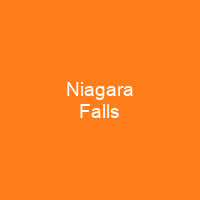Discovering the Majestic Wonder: Niagara Falls
Niagara Falls is a group of three waterfalls on the border between Canada and the US. The largest, Horseshoe Falls, straddles the international border. It’s known as the Canadian Falls and is the most powerful waterfall in North America. How can such a natural wonder be so awe-inspiring?
The Formation of Niagara Falls
Niagara Falls was formed by glaciers receding at the end of the last ice age, cutting a gorge through the north-facing cliff. The rocky bed eroded unevenly due to interactions of three major rock formations: hard limestone and dolomite, weaker shale, and ancient fossils in the lower valley. Over time, the river eroded the soft layer supporting the hard layers, causing the caprock to give way in great chunks. The falls retreated 10.9 kilometers southward as erosion caused its shape to change from a small arch to a horseshoe bend.
Preservation Efforts
Erosion continued at a rate of approximately 30 centimeters per year, with projections suggesting the falls will erode the remaining 32 kilometers to Lake Erie in about 50,000 years. Industrialization and lack of public access led to conservation efforts, including Free Niagara, which aimed to establish a public park on Goat Island. How can we ensure that future generations continue to marvel at this natural wonder?
The Birth of State Parks
In 1879, Olmsted and James T. Gardner surveyed Niagara Falls and created a report advocating for state purchase and preservation of the scenic lands surrounding the falls. The New York State legislature commissioned the report, which described restoration as a ‘sacred obligation to mankind.’ In 1883, Governor Grover Cleveland drafted legislation authorizing the acquisition of lands for a state reservation at Niagara. In 1885, Governor David B. Hill signed legislation creating the Niagara Reservation, New York’s first state park.
Tourism and Hydroelectric Power
The energy of Niagara Falls has been recognized as a potential source of power since 1750, with various companies and individuals attempting to harness its energy over the years. In 1881, Jacob F. Schoellkopf built the first hydroelectric generating station on the Niagara River, generating direct current electricity. The Niagara Falls Power Company expanded on this idea, leading to the development of a large-scale AC power system in 1895. How can we balance harnessing nature’s energy with preserving its beauty?
The Rainbow Bridge
A two-level suspension structure was commissioned in 1869, but destroyed during a storm in 1889. A replacement was built quickly and opened in 1889, followed by a steel bridge in 1897 known as the Honeymoon Bridge. The Niagara Cantilever Bridge was opened in 1883 and remained in use until it was replaced by a new rail bridge in 1925. The Rainbow Bridge opened in November 1941 and remains in use today.
Hydroelectric Power Today
The Niagara Falls hydroelectric power plant uses water passing through turbines to supply power to nearby areas. During low demand, the Lewiston units can pump water back up to the reservoir; during peak demand, they generate electricity. A 1950 treaty preserves the natural beauty by limiting water usage, requiring specific flow rates for daylight and nighttime hours. The Power Authority of New York and Ontario Power Generation work together to prevent ice on the Niagara River from interfering with power production or causing flooding. How can we continue to harness this energy while ensuring the falls remain a wonder for all?
Stunts and Tourism
Tourism at Niagara Falls includes peak visitor traffic in summer, the Maid of the Mist boat cruise since 1846, American Falls and Goat Island with various attractions and views, Niagara Scenic Trolley, helicopter tours, and Niagara Gorge Discovery Center. Attractions on the Canadian side include Queen Victoria Park with gardens, platforms, and underground walkways, Niagara River Recreational Trail with historical sites from the War of 1812, Tower Hotel, Whirlpool Aero Car, and Journey Behind the Falls.
Notable Stunts
Nik Wallenda became the first person to walk across Horseshoe Falls in 116 years on June 15, 2012. How can we continue to push the boundaries of human achievement while respecting nature’s power?
Conclusion
Niagara Falls is a testament to nature’s grandeur and our ongoing efforts to preserve it for future generations. From its formation by glaciers to the modern-day harnessing of hydroelectric power, this natural wonder continues to captivate us with its beauty and power. As we explore the history and attractions surrounding Niagara Falls, let us remember the importance of balancing human innovation with environmental stewardship.

You want to know more about Niagara Falls?
This page is based on the article Niagara Falls published in Wikipedia (retrieved on January 31, 2025) and was automatically summarized using artificial intelligence.






